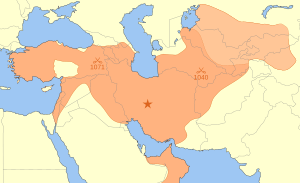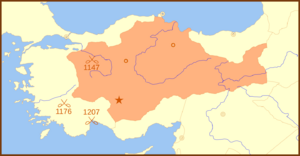Seljuk dynasty facts for kids
The Seljuks were a powerful Muslim family who created a large empire. They ruled parts of Central Asia and the Middle East from the 11th to the 14th centuries. Their empire, called the Great Seljuk Empire, stretched all the way from Anatolia (modern-day Turkey) to Pakistan. The Seljuks were also involved in the First Crusade, fighting against Christian armies.
The Seljuks were ancestors of the people who live in modern-day Azerbaijan, Turkey, and Turkmenistan. They originally belonged to a group called the Kinik Oghuz Turks. In the 9th century, these Turks lived in the grasslands north of the Caspian Sea and Aral Sea.
Contents
Who Were the Seljuk Rulers?
The Seljuk Empire was led by a series of powerful rulers, often called Sultans. Here are some of the most important leaders of the main Seljuk Dynasty:
- Tugrul I (Tugrul Beg) (1037-1063): He is considered the founder of the Great Seljuk Empire.
- Alp Arslan (1063-1072): A famous military leader who won important battles.
- Jalal ad-Dawlah Malik Shah I (1072-1092): Under his rule, the empire reached its greatest size and power.
- Rukn ad-Din Barkiyaruq (1093-1104)
- Ghiyath ad-Din Muhammad I Tapar (1105-1118)
- Mu'izz ad-Din Ahmed Sanjar (1131-1157): The last powerful Sultan of the Great Seljuk Empire.
The Seljuk Sultanate of Rüm in Anatolia
After the main Seljuk Empire started to decline, a new Seljuk state grew strong in Anatolia (modern-day Turkey). This was called the Sultanate of Rüm. It was very important in the history of Turkey.
Here are some of the key rulers of the Sultanate of Rüm:
- Süleyman Ibn Kutalmish (1077-1086): He founded the Sultanate of Rüm.
- Dawud Kilij Arslan I (1092-1107): He fought against the Crusaders.
- Rukn ad-Din Mas'ud I (1116-1156)
- Izz ad-Din Kilij Arslan II (1156-1192)
- Ghiyath ad-Din Kay Khusrau I (1192-1196 and 1205-1211)
- Izz ad-Din Kay Ka'us I (1211-1220)
- Ala ad-Din Kay Qubadh I (1220-1237): His reign is often seen as the golden age of the Sultanate of Rüm.
- Ghiyath ad-Din Kay Khusrau II (1237-1246)
- Izz ad-Din Kay Ka'us II (1246-1260)
- Rukn ad-Din Kilij Arslan IV (1248-1265)
- Ghiyath ad-Din Kay Khusrau III (1265-1282)
- Ghiyath ad-Din Mas'ud II (ruled multiple times between 1282-1307)
Images for kids
-
Head of a Seljuk royal figure from Iran, 12th–13th century. This art piece is kept at the New York Metropolitan Museum of Art.
-
The Toghrol Tower, a 12th-century monument near Tehran, built to honor Toğrül.
-
A beautiful Seljuk-era Ewer (a type of pitcher) from Herat, Afghanistan, made between 1180–1210. It's made of brass with silver designs.
-
A Shatranj (an old form of chess) set from 12th-century Iran, made of glazed fritware. It's also at the New York Metropolitan Museum of Art.
-
A Seljuk sarcophagus (stone coffin) at the Eskişehir Eti Archaeology Museum.
See also
 In Spanish: Dinastía selyúcida para niños
In Spanish: Dinastía selyúcida para niños









